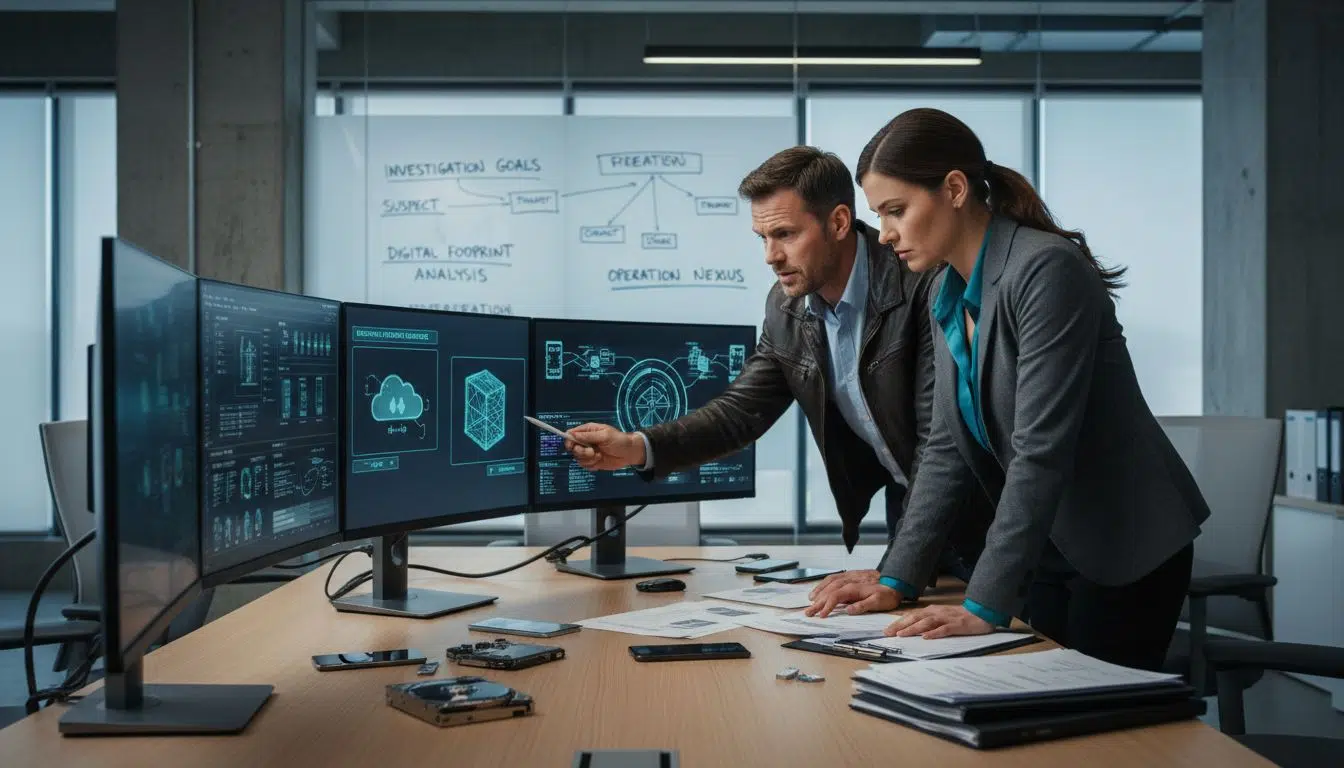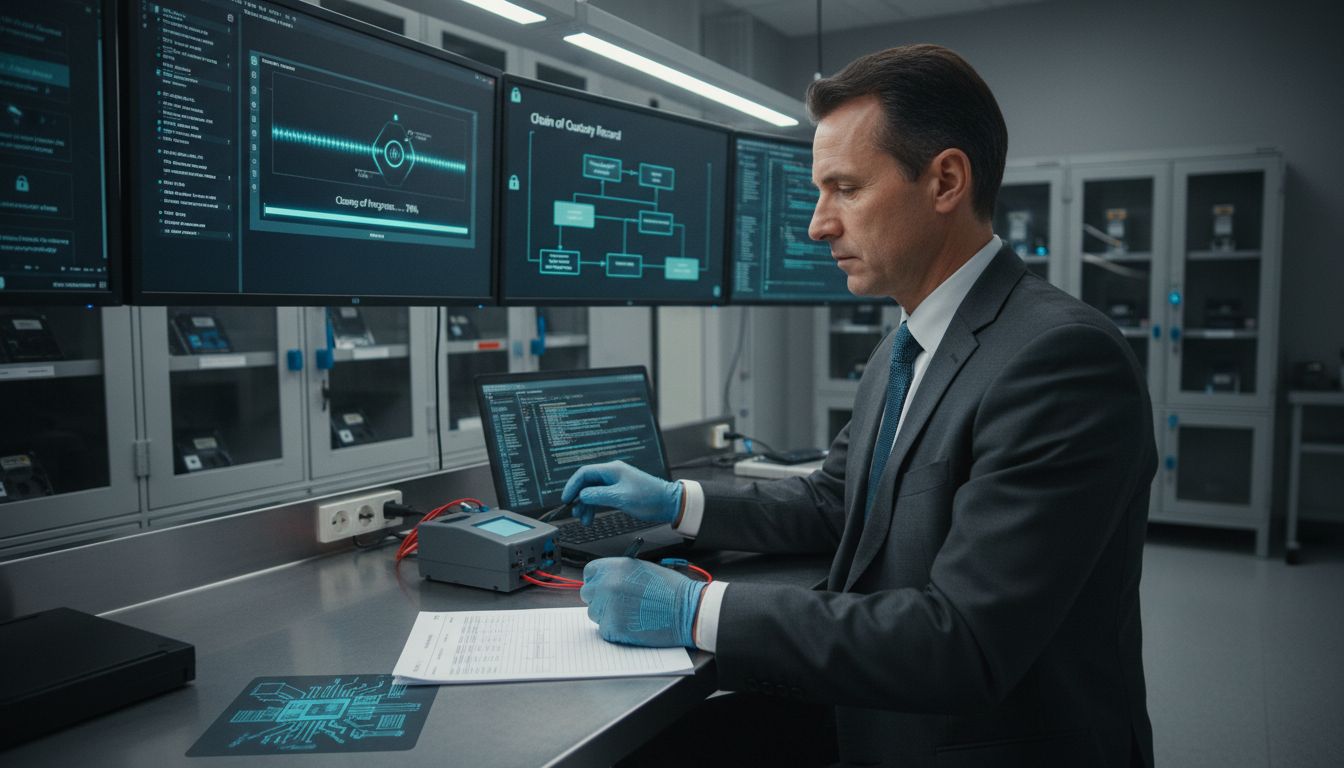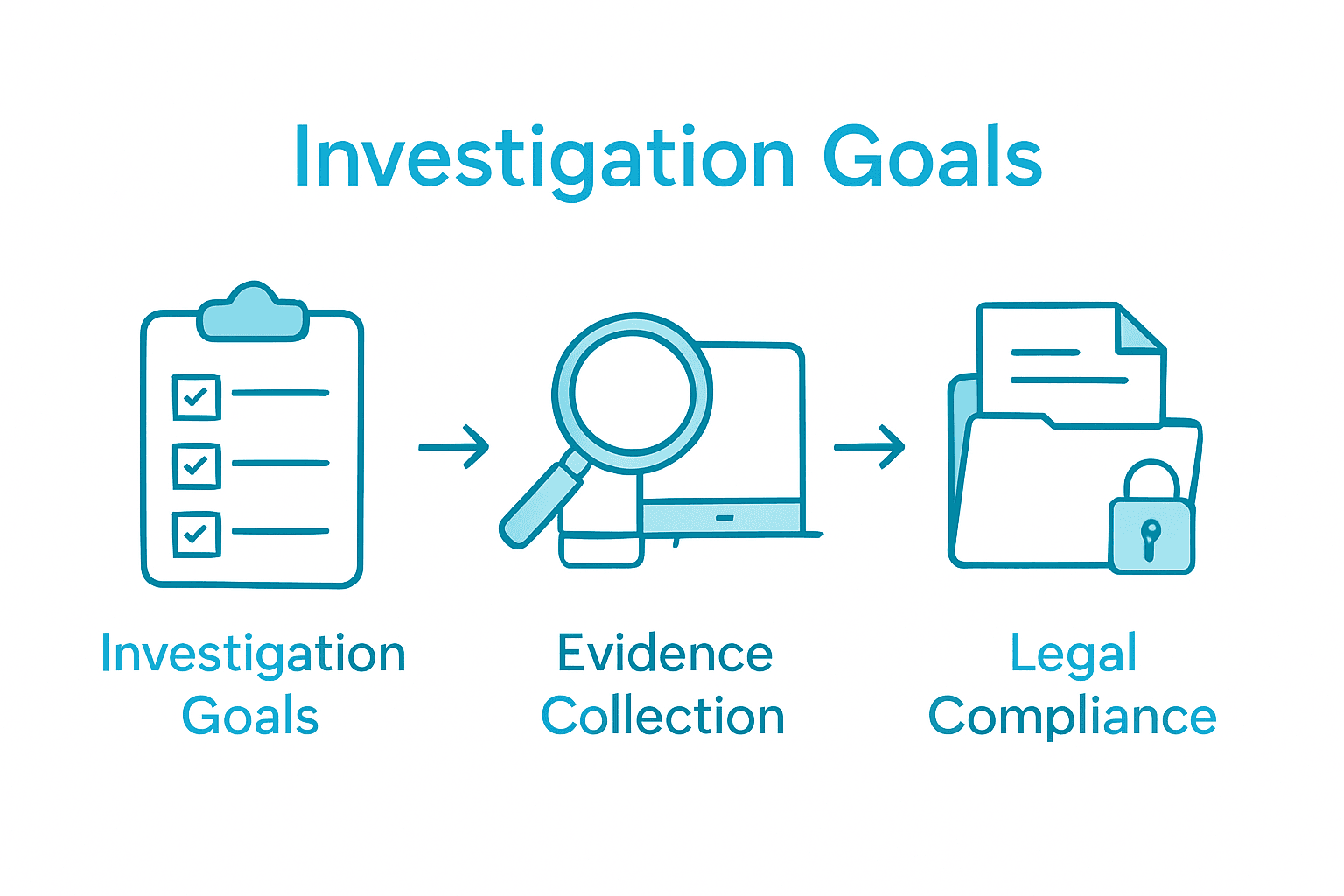Nearly every high profile british cyber investigation succeeds or fails based on clear teamwork from the start. Digital forensics demands close collaboration not only between technical experts but also legal professionals, and mistakes in the early stages can jeopardise the entire process. By outlining critical steps such as defining shared objectives, choosing relevant evidence, and ensuring legal compliance, this guide reveals how a focused, structured approach empowers investigators to secure reliable, court-ready results.
Table of Contents
- Stage 1: Identify Collaborative Investigation Goals
- Stage 2: Select Relevant Digital Evidence Sources
- Stage 3: Collect and Preserve Digital Data Securely
- Stage 4: Analyse Digital Evidence with Forensic Tools
- Stage 5: Prepare Expert Witness Reports
- Stage 6: Verify Findings and Ensure Legal Compliance
Quick Summary
| Key Insight | Explanation |
|---|---|
| 1. Clearly Define Investigation Goals | Collaborative discussions among stakeholders help establish clear objectives to improve forensic outcomes. |
| 2. Prioritise Evidence Sources | Assess the relevance of potential digital evidence to focus on the most critical sources of information. |
| 3. Maintain Chain of Custody | Document every interaction with digital evidence to ensure its integrity and legal admissibility. |
| 4. Use Appropriate Forensic Tools | Select specialised tools for analysing digital evidence, ensuring systematic and comprehensive examination. |
| 5. Verify Legal Compliance | Ensure all collected data meets legal standards through thorough verification and documentation of methodologies. |
Stage 1: Identify Collaborative Investigation Goals
Successful computer forensic investigations depend on clearly defining shared objectives between investigators, legal professionals, and digital forensics specialists. According to the High Technology Crime Investigation Association, effective digital forensics requires collaborative approaches across multiple professional domains.
When identifying investigation goals, start by scheduling an initial strategy meeting with all key stakeholders. During this meeting, outline specific parameters such as the scope of investigation, potential evidence types, anticipated challenges, and desired outcomes. Your collaborative discussion should cover critical questions like: What specific digital artefacts are you seeking? Which devices or systems require forensic examination? What legal or regulatory constraints might impact your investigation?
A practical tip when establishing investigation goals is to create a structured documentation framework that captures every participant’s expectations and requirements. This approach ensures transparency and helps prevent misunderstandings later in the investigative process. By meticulously defining goals upfront, you significantly improve the likelihood of a successful digital forensic examination that meets all stakeholders’ investigative needs.
Your next stage will involve developing a comprehensive forensic acquisition and preservation strategy based on these clearly defined collaborative goals.
Stage 2: Select Relevant Digital Evidence Sources
Selecting the most relevant digital evidence sources requires a strategic and systematic approach to ensure comprehensive forensic investigation. According to research from Binus University, potential digital evidence can be found across multiple devices and platforms, including computers, smartphones, tablets, servers, external drives, and cloud storage systems.
Begin by conducting a thorough inventory of all potential digital sources connected to your investigation. This means mapping out every digital device, network system, and online platform that might contain relevant information. Consider both physical devices and digital environments such as email accounts, social media platforms, cloud storage services, and collaborative workspaces. Pay special attention to primary devices like personal computers, work laptops, mobile phones, and backup storage systems that are most likely to preserve critical evidence.
A practical tip is to prioritise your evidence sources based on their potential relevance and likelihood of containing actionable information. Not all digital sources are equally valuable, so develop a hierarchical approach that focuses first on the most probable repositories of evidence. Learn more in our comprehensive guide on digital evidence collection.
Once you have identified and prioritised your digital evidence sources, you will move on to planning the precise forensic acquisition strategy that ensures legal admissibility and comprehensive data preservation.
Stage 3: Collect and Preserve Digital Data Securely
Securing and preserving digital evidence requires meticulous attention to detail and a systematic forensic approach. According to Hawkeye Forensic, effective digital evidence collection involves creating forensic images, prioritising volatile data, and comprehensively documenting each investigative step to maintain absolute data integrity.
Begin by establishing a secure forensic workstation isolated from network connections to prevent potential data contamination or external interference. Utilise write blockers when accessing digital storage devices to ensure no unintended modifications occur during the evidence collection process. Create bit-by-bit forensic images of all relevant digital media, capturing every sector and preserving the original data structure exactly as discovered. Document the entire acquisition process with precise timestamps, hash values, and detailed notes describing the condition and configuration of each piece of digital evidence when initially encountered.
A critical tip is to maintain an unbroken chain of custody throughout your evidence collection. Learn more about digital forensics chain of custody procedures to understand how to meticulously track and document every interaction with digital evidence. This approach ensures that your collected data remains legally admissible and scientifically defensible in potential legal proceedings.
With your digital evidence securely collected and preserved, you will now proceed to the analysis phase where forensic experts will systematically examine the acquired data to uncover critical investigative insights.
Stage 4: Analyse Digital Evidence with Forensic Tools
Analysing digital evidence requires a systematic and methodical approach that transforms raw data into meaningful investigative insights. According to research from the International Journal of Advanced Research in Computer and Communication Engineering, the digital forensic analysis phase involves carefully examining collected evidence using specialised forensic tools to uncover critical information.
Begin by selecting appropriate forensic analysis tools tailored to the specific digital platforms and file types you are investigating. This might include memory analysis software, registry examination tools, network traffic analysers, and file recovery utilities. Develop a structured workflow that prioritises volatile data preservation and systematic examination. Create forensic snapshots that capture the system state precisely at the moment of investigation, allowing you to examine digital artefacts without risking data modification. Explore our comprehensive guide to essential forensic analysis tools for legal teams to understand the most effective technologies for your specific investigative requirements.
A critical tip during digital evidence analysis is maintaining meticulous documentation of every tool used, analysis technique applied, and finding discovered. This forensic transparency ensures that your investigative process remains scientifically rigorous and legally defensible. By carefully tracking your methodology, you create a comprehensive audit trail that can withstand potential legal scrutiny.
With your digital evidence thoroughly analysed, you will now prepare to compile your findings into a comprehensive forensic report that communicates your investigative discoveries clearly and professionally.
Stage 5: Prepare Expert Witness Reports
Preparing expert witness reports represents the critical culmination of your digital forensic investigation where scientific rigour meets legal documentation. According to research from the International Journal of Advanced Research in Computer and Communication Engineering, proper documentation during the presentation phase is fundamental to establishing the credibility of digital forensic findings.
Construct your expert witness report with meticulous attention to detail, ensuring comprehensive coverage of your investigative methodology. Begin by creating a structured document that systematically presents your technical findings, including detailed descriptions of forensic tools used, analysis techniques applied, and specific digital evidence examined. Include clear timelines, precise technical explanations, and unambiguous statements about your discoveries. Ensure that your report is written in language accessible to legal professionals who may not possess advanced technical expertise, translating complex digital forensic concepts into clear, comprehensible narratives. Learn more about our computer expert witness services for legal proceedings.
A critical tip when preparing expert witness reports is maintaining absolute objectivity and scientific neutrality. Your documentation must represent an impartial, fact based analysis that can withstand rigorous legal scrutiny. This means presenting both confirming and contradictory evidence, explaining your methodological approach, and providing transparent insights into how you reached your conclusions.
With your expert witness report meticulously prepared, you are now ready to present your forensic findings to legal professionals, potentially providing crucial evidence that could significantly impact the investigation or legal proceedings.
Stage 6: Verify Findings and Ensure Legal Compliance
Ensuring legal compliance represents the final critical validation stage of your digital forensic investigation. According to research from American Military University, digital evidence must strictly adhere to admissibility rules and regulatory standards to guarantee its relevance, authenticity, and lawful acquisition.
Begin your verification process by conducting a comprehensive cross-referencing review of all collected evidence, ensuring that each digital artefact can be independently authenticated and traced back to its original source. Validate the forensic tools and methodologies used during your investigation, confirming that they meet established legal and scientific standards. Pay particular attention to maintaining an unbroken chain of custody, documenting every interaction with digital evidence and preserving the integrity of your investigative process. Learn more about digital document authentication techniques to understand the nuanced requirements of legal evidence verification.
A critical tip when verifying digital forensic findings is to anticipate potential legal challenges by proactively addressing any potential weaknesses in your investigative methodology. This means critically examining your own findings, identifying potential alternative interpretations, and preparing robust explanations for how you reached your conclusions. By maintaining transparency and demonstrating scientific rigour, you significantly enhance the credibility of your forensic evidence in legal proceedings.
With your findings verified and legal compliance confirmed, you are now prepared to present your comprehensive digital forensic investigation results to legal professionals or stakeholders.
Unlock the Full Potential of Computer Forensic Expertise
Private investigators face complex challenges when handling digital evidence ranging from data recovery to analysing mobile devices and cloud data. The article highlights crucial needs such as precise collection of digital evidence, maintaining an unbroken chain of custody, and preparing expert witness reports that withstand legal scrutiny. These pain points demand not only technical mastery but also clear documentation and legal compliance to support successful investigations.
At Computer Forensics Lab, we empower private investigators by offering specialist support tailored to these exact challenges. Whether you require expert handling of mobile evidence through our Forensic Mobile Specialists, or detailed and impartial scientific reporting from our Expert Witness team, our London-based services combine cutting-edge forensic techniques with legal rigor. Don’t risk evidential gaps or procedural errors. Discover how our digital forensics expertise can give your investigations the clarity and credibility they deserve.
Explore the advantages of partnering with Computer Forensics Lab today and ensure your forensic evidence is admissible and robust when it matters most.
Frequently Asked Questions
How do computer forensic experts assist private investigators in gathering evidence?
Computer forensic experts aid private investigators by systematically collecting and analysing digital evidence from various sources. They ensure that the evidence is preserved properly and is legally admissible in court.
What steps should private investigators take to work effectively with computer forensic experts?
Private investigators should begin by clearly defining their investigation goals and the types of digital evidence they require. Collaborate during initial meetings to establish parameters and maintain thorough documentation to streamline the forensic process.
How can computer forensic analysis contribute to the success of a private investigation?
Computer forensic analysis can uncover critical information that may not be visible through traditional investigative methods. It allows for the identification of digital artefacts that could support or refute claims within a case, increasing the likelihood of a successful outcome.
What types of digital evidence can computer forensic experts collect for private investigations?
Computer forensic experts can collect evidence from various digital sources, including computers, smartphones, tablets, and cloud storage. This comprehensive collection ensures that all relevant data is reviewed and preserved for analysis.
How do computer forensic experts maintain the integrity of digital evidence during investigations?
Experts maintain evidence integrity by following strict protocols, including creating forensic images and documenting every interaction with the evidence. This unbroken chain of custody is essential for ensuring that the evidence is admissible in legal proceedings.
What is the importance of expert witness reports in private investigations?
Expert witness reports are crucial as they present the findings of computer forensic analyses in a manner that is clear and understandable to legal professionals. These reports help substantiate findings and can significantly impact the direction of legal proceedings.
Recommended
- Computer Forensics Expert
- Complete Guide to Computer Forensics Specialists
- Computer Forensics Lab | Digital forensic investigations into civil and criminal cases for law firms, businesses and private clients in London, UK
- Computer Forensics Lab | Digital forensic investigations into civil and criminal cases for law firms, businesses and private clients in London, UK


